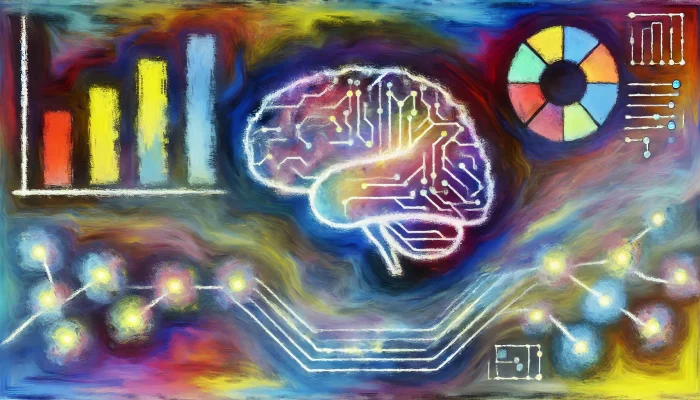Bridging the Gap Between Business Intelligence and AI: A Practical Guide
How to Activate your Augmented Analytics Strategy

Exciting breakthroughs in Business Intelligence (BI) and Artificial Intelligence (AI) are reshaping industries across the globe. Now is the perfect time to harness these innovations for your business’ success.
For example, did you know that 71% of businesses integrating AI into their BI strategies see at least a 5% revenue increase, and 44% see an increase of over 10%? Plus, organisations implementing AI-driven BI have accelerated their decision-making processes, making strategic choices up to 5 times faster due to real-time data insights and predictive analytics.
Read on to find out how you can activate an augmented analytics strategy that revolutionises your business.
Business Intelligence Trends
Let’s start with a run-through of the major current business Intelligence (BI) trends we’re seeing being applied today.
Cloud Integration: Businesses are increasingly looking to accelerate their growth by migrating BI tools to cloud platforms like AWS, Azure, and Google Cloud. This strategic move isn’t just about staying current – it’s about gaining unparalleled scalability and accessibility that drive innovation and competitive edge.
Advanced Analytics: The evolution towards predictive and prescriptive analytics is revolutionising the BI landscape, and it’s all about leveraging machine learning to stay ahead. Forward-thinking companies are harnessing machine learning models within their BI platforms to not just understand what has happened, but to predict what will happen and prescribe actionable strategies. This shift is enabling businesses to anticipate market trends, personalise customer experiences, and optimise operations like never before.
Natural Language Processing (NLP): Embracing Natural Language Processing (NLP) within BI tools is reshaping the way businesses interact with data – making analytics more intuitive and accessible than ever before. Teams are now able to engage with complex data systems using everyday language, breaking down technical barriers and empowering people across organisational levels to gain swift, actionable insights.
Data Democratisation: The future of business intelligence is all about empowering every member of your team with easy access to data – no PhD in data science required. Industry leaders are pulling ahead by making data accessible to non-technical users through intuitive interfaces and self-service analytics. Organisations democratising their data in this way see a significant boost in agility and innovation, as employees can make informed decisions without bottlenecks. Self-service analytics is not just a feature – it’s a necessity for businesses aiming to foster a data-driven culture and stay competitive.

Artificial Intelligence Tends
Let’s now take a look at the Artificial Intelligence (AI) trends most businesses are already exploring.
Machine Learning (ML): ML algorithms are the driving force propelling AI’s most incredible advancements, powering everything from image recognition and natural language understanding to cutting-edge predictive analytics.
AI Ethics: There’s a growing emphasis on ethical AI practices, ensuring fairness, transparency, and accountability in AI models and deployments. Embracing ethical AI practices isn’t just a moral choice however, it’s a strategic imperative for risk mitigation and stakeholder confidence.
AI in Automation: Harnessing AI for process automation is a game-changer that’s propelling businesses into a new era of efficiency and innovation. Companies are leveraging AI to automate complex processes, achieving cost reductions of up to 30% and significantly speeding up time-to-market, with one UK auto insurer seeing a 330% return on investment. Integrating AI into operations is not simply about automating away labour, it’s about reinventing how work gets done to help teams unlock unprecedented value.
Conversational AI: The days of the exasperating phone-tree are over – AI-driven chatbots and virtual assistants are taking customer engagement to the next level with more natural and context-aware interactions. Businesses implementing AI chatbots have seen customer satisfaction scores soar, while also freeing up human agents to tackle more complex issues by automating up to 80% of straight-through processing.

Bridging the Gap
The convergence of BI and AI is completely changing the way businesses harness data, unlocking unprecedented strategic insights and operational efficiencies. Let’s dive into three key areas where this integration is making a significant impact, backed by insights from real-life examples.
AI-Powered Analytics
Predictive and Prescriptive Analytics: Traditional BI excels at descriptive analytics, essentially summarising past performance. AI elevates this by introducing predictive analytics – forecasting future trends – and prescriptive analytics, which suggests actionable strategies based on those predictions. Machine learning models uncover patterns and insights that traditional BI might overlook, enabling businesses to make proactive, data-driven decisions.
Real life example: At the Data and AI Summit 2024 in San Francisco, one of Trip Advisor’s marketing partners presented a case study highlighting how a large language model (LLM) processes real-time reviews and conducts sentiment analysis, evaluating and scoring the content, and storing it in a data lake. At the same time, Tableau pulls real-time data from this lake to deliver insights to various business groups. Hotels and hospitality vendors can access review scores across their properties, allowing them to respond to customer issues more quickly, achieving a 3x improvement in response time. Meanwhile, Trip Advisor can monitor supply and demand trends across vendors with a 4x improvement in efficiency.
Natural Language Processing (NLP)
Text Analytics: NLP transforms unstructured data – such as customer feedback, social media posts, and reviews – into actionable insights. Incorporating this rich data into BI dashboards provides a holistic view of the business landscape, going beyond traditional numeric metrics to help users truly understand customer sentiment and market trends.
Real life example: A recent case study from Wavicle highlighted how McDonald’s enhanced customer satisfaction, just by using AI text analytics. The company applied sentiment analysis to customer satisfaction surveys and social media data to gain actionable insights. Built on AWS with Talend and Tableau for the front end. This solution enabled McDonald’s to analyse 95,000 comments, categorise them by topic, and group them into themes. The insights were then segmented into various views and shared with different business teams through BI dashboards. This approach improved the speed of analysis by 10% and increased accuracy by 70%.
Personalization and Contextual Insights
Tailored Recommendations: AI can personalise BI reports and dashboards for individual users or departments by analysing usage patterns, historical data, and preferences. This ensures that insights are not only relevant but also actionable, enhancing efficiency and decision-making at every organisational level.
Real life example: At Dreamforce 2024, Salesforce showcased several successful case studies centred around personalization and consumer personas. One standout example was Wyndham, with its 9,200 locations and 100 million-member loyalty program. Using Consumer360, Salesforce Cloud, and AI-powered data agents, Wyndham built a comprehensive ecosystem that gathers consumer signals, updates existing personas, and recommends actions for service agents. All insights are delivered in real-time through dashboards in Consumer360 and Tableau. The company reported a consistent 40% year-over-year improvement in customer support response times and a 15% increase in customer satisfaction survey results.

Summing Up
Integrating AI into BI platforms doesn’t just accelerate crunching numbers, it unlocks data’s full potential to drive innovation, customer engagement, and substantial revenue growth. Forward thinking companies like Tripadvisor, Salesforce, and McDonalds are already leading the charge, with their next-level success demonstrating that augmented analytics – connected BI and AI – is the key to staying ahead in today’s competitive landscape.
The future belongs to businesses that can adapt and innovate. By embracing the fusion of BI and AI, you’re not just keeping up with the times – you’re setting the pace for what’s next.
Latest News
- November 14, 2024
How AI is Enhancing Self-Service BI
- October 29, 2024
Gartner Technology Adoption 2024 – An Opinion
- October 17, 2024
Bridging the Gap Between Business Intelligence and AI
- July 14, 2023






1 Comment